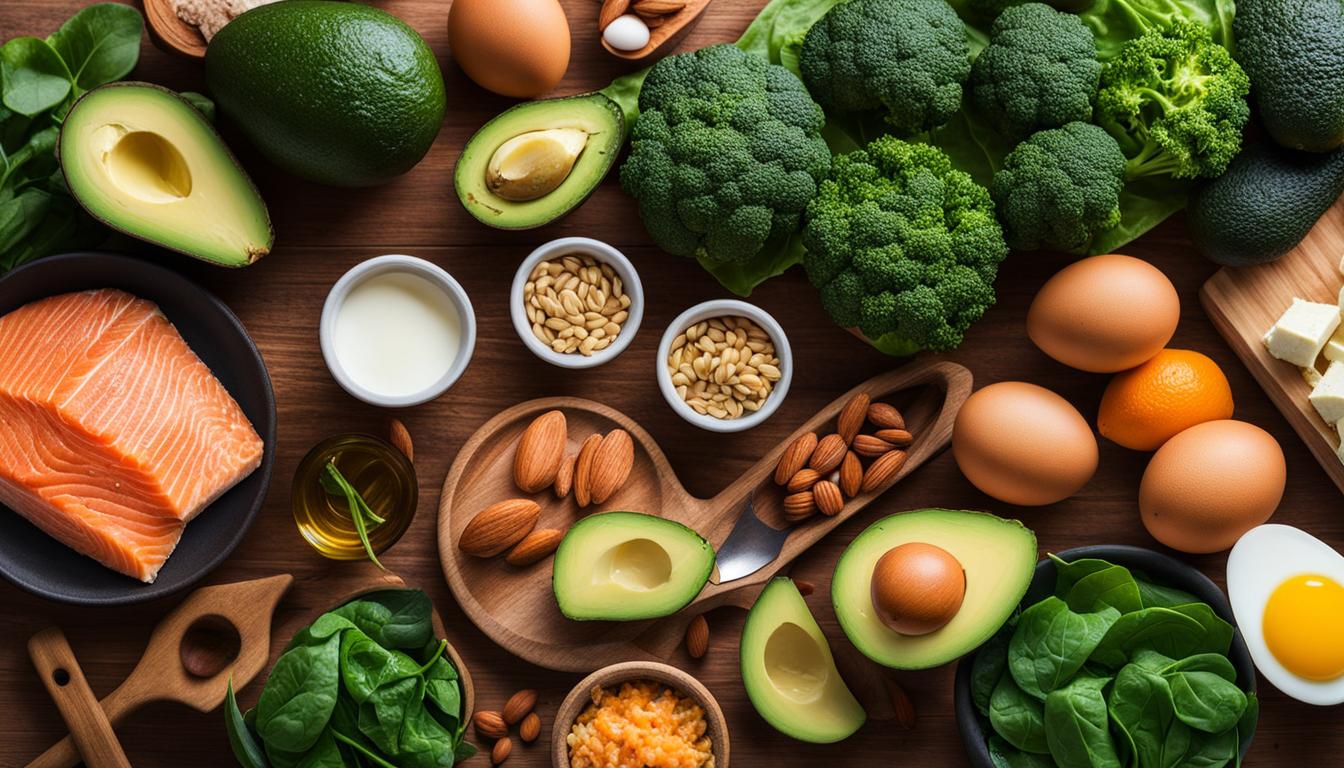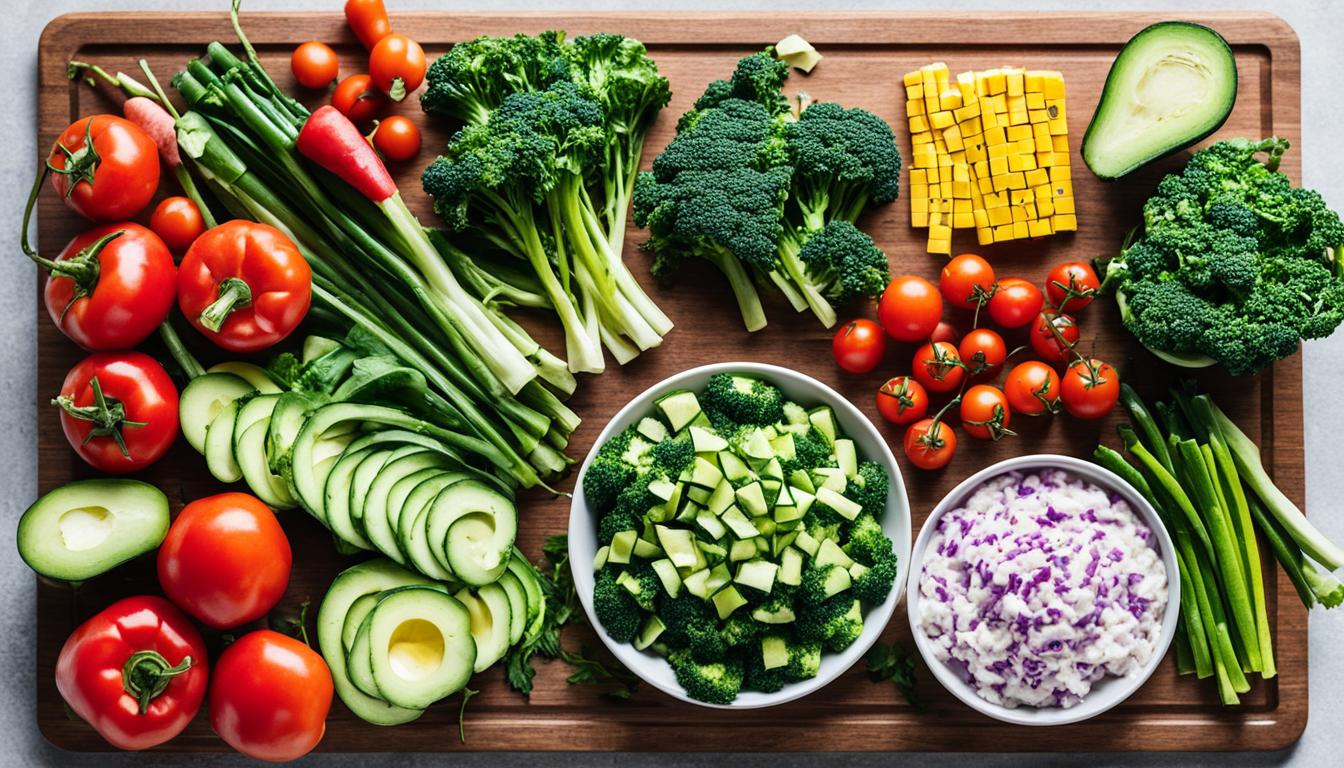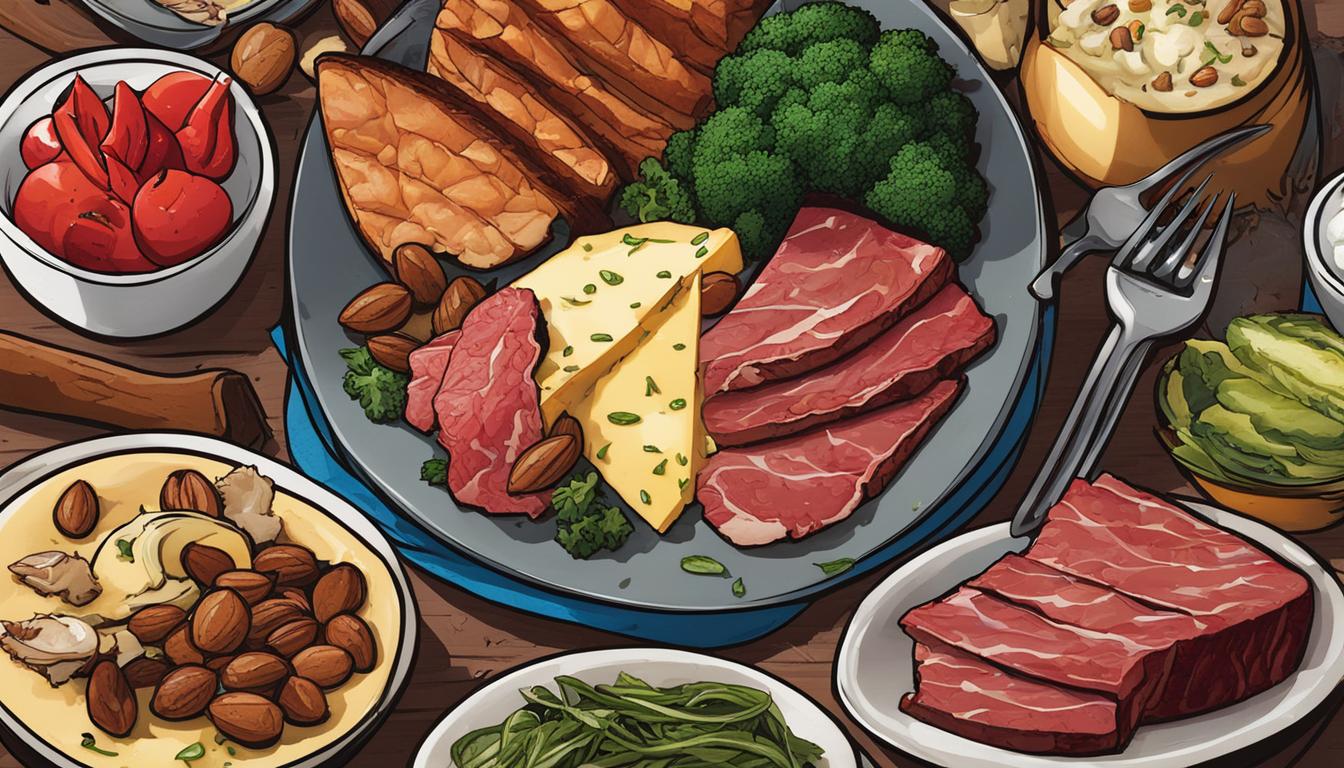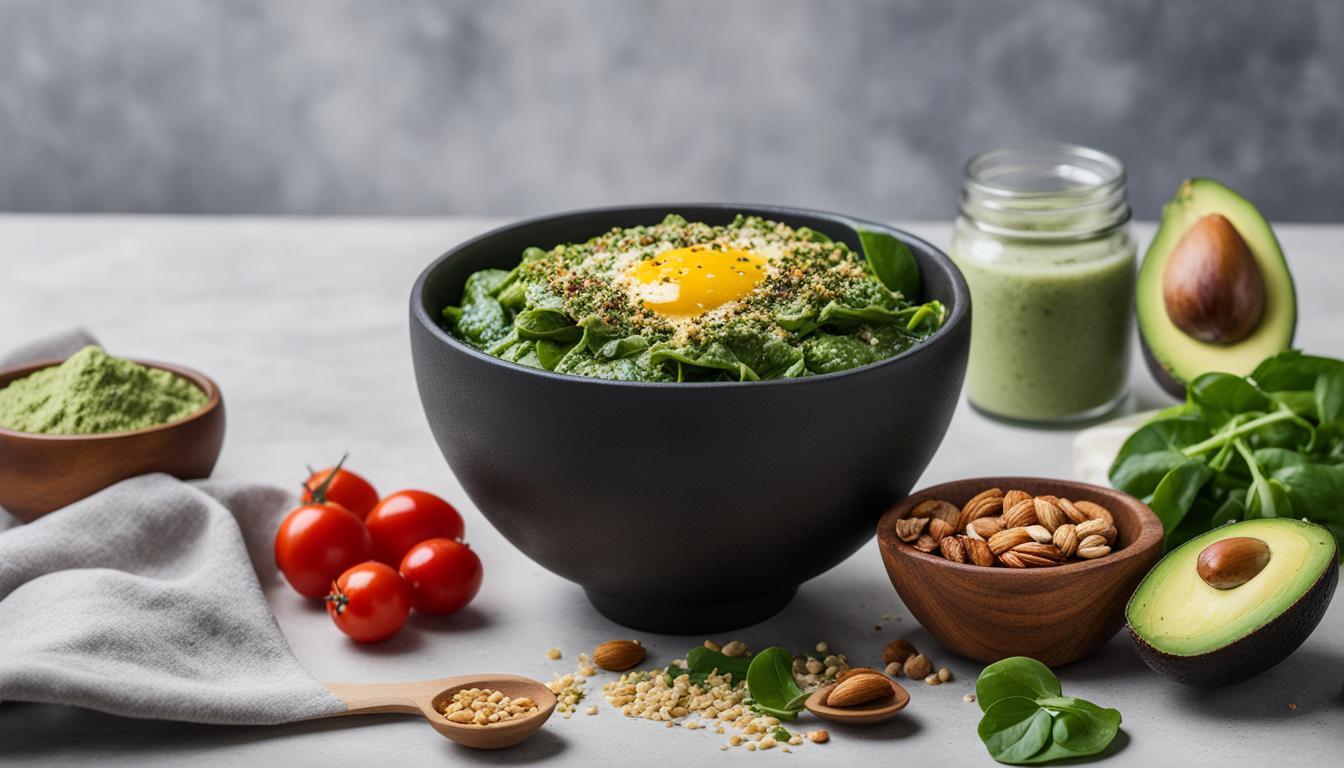A keto grocery list is crucial for those starting the keto diet, as it helps plan structured meals and avoid impulse purchases. The keto diet is low-carb, high-fat, and moderate-protein, with a focus on keeping carbs under 50 grams per day. Quality proteins such as meat, seafood, and eggs are staples, along with healthy fats like butter and coconut oil. Non-starchy vegetables and low-sugar fruits are included, while processed foods, grains, and high-carb fruits and vegetables are avoided.
Key Takeaways:
- A keto grocery list is essential for planning structured meals on the keto diet.
- The keto diet is low-carb, high-fat, and moderate-protein, with a focus on keeping carbs under 50 grams per day.
- Quality proteins such as meat, seafood, and eggs are staples on the keto diet.
- Healthy fats like butter and coconut oil are important for a keto meal plan.
- Non-starchy vegetables and low-sugar fruits are included, while processed foods, grains, and high-carb fruits and vegetables are avoided.
Getting Started on the Keto Diet
The keto diet, short for ketogenic diet, is a low-carb, high-fat eating plan that helps the body enter a state of ketosis. Ketosis is when the body starts burning fat for fuel instead of glucose. To successfully begin the keto diet, it’s important to understand the macro breakdown and limit carb intake. The recommended macros for the keto diet are 5% or fewer carbs, 70-80% fats, and 20-30% protein.
When following the keto diet, it’s crucial to keep carb consumption under 50 grams per day to achieve ketosis. Some individuals may choose to go as low as 20 grams of carbs or even eliminate carbs entirely. However, it’s important to note that transitioning to a ketogenic state can lead to temporary symptoms known as the keto flu. These symptoms include fatigue, dizziness, and irritability but subside as the body adapts to using fat as its primary source of energy.
To ensure a successful start on the keto diet, it’s essential to have a definitive keto grocery list. This list will provide a variety of keto-friendly food options, making it easier to plan and prepare meals while maintaining ketosis. With the right foods on hand, you can create delicious and satisfying meals that adhere to the guidelines of the keto diet.
Having a robust keto grocery list allows you to stock up on a wide range of keto-friendly ingredients, ensuring that you are equipped to follow the diet effectively.
| Keto Diet Grocery List |
|---|
| Quality proteins (meat, poultry, seafood) |
| Healthy fats (butter, coconut oil, avocado oil) |
| Non-starchy vegetables (leafy greens, cauliflower) |
| Low-sugar fruits (berries, avocados) |
| Eggs and dairy products (butter, heavy cream, cheese) |
| Low-carb condiments (olive oil, mayonnaise) |
| Keto-friendly snacks (nuts, seeds) |
By adhering to this keto grocery list, you can ensure your pantry is filled with all the necessary ingredients needed to create flavorful and satiating meals. Additionally, having a variety of food options will help you stay motivated and enjoy the process of adapting to the keto diet.
Now that you have a clear understanding of the basic principles of the keto diet and the importance of a comprehensive grocery list, you are ready to embark on your keto journey. Remember to tailor your grocery list to your personal preferences while staying within the parameters of the keto diet. With careful planning and the right ingredients, you can achieve your health and weight loss goals on the keto diet.
What to Include in Your Keto Grocery List
A keto grocery list is essential for stocking your pantry with the right ingredients to support a successful ketogenic diet. When compiling your keto shopping list, it’s important to focus on low-carb, high-fat foods that will keep you in ketosis. Here are some key items to include:
Healthy Fats
Healthy fats are a cornerstone of the keto diet. They provide energy and help keep you feeling satiated. Here are some keto-friendly sources of healthy fats to include in your grocery list:
- Avocado oil
- Coconut oil
- Extra virgin olive oil
- Grass-fed butter
Quality Proteins
Protein is an essential component of any diet, including keto. When choosing proteins for your keto grocery list, opt for high-quality sources with minimal carbs:
- Grass-fed beef
- Free-range poultry
- Wild-caught seafood
- Egg whites
Non-Starchy Vegetables
Non-starchy vegetables are an excellent source of fiber and nutrients while keeping carbohydrate intake low. Include a variety of non-starchy vegetables in your keto shopping list:
- Leafy greens like spinach and kale
- Cauliflower
- Zucchini
- Broccoli
Keto-Friendly Fruits
While fruits are generally higher in carbs, there are some keto-friendly options that can add variety to your diet. Include these fruits in moderation on your keto grocery list:
- Avocados
- Berries like strawberries and blueberries
- Coconut
Eggs and Dairy Products
Eggs and dairy products are rich in protein and fat, making them perfect for a keto diet. Add these items to your keto shopping list:
- Butter
- Heavy cream
- Natural cheeses
Low-Carb Condiments and Sweeteners
Enhance the flavor of your keto meals with low-carb condiments and sweeteners. Here are some keto-friendly options to consider:
- Sugar-free ketchup
- Mustard
- Mayonnaise
- Stevia or monk fruit sweetener
Remember, everyone’s dietary needs may vary, and it’s important to adjust your grocery list to fit your preferences and goals. Experiment with different keto-friendly ingredients to keep your meals exciting and enjoyable.
What to Avoid in Your Keto Grocery List
A keto grocery list should exclude highly processed foods with added sugars, vegetable oils, and grains. High-carb fruits and vegetables, as well as traditional snacks like cakes, cookies, and soda, should be avoided. Certain oils like canola and soybean oil can also be detrimental to a ketogenic diet. The focus should be on whole, unprocessed foods that are low in carbs and high in healthy fats and protein.
Foods to Avoid on a Keto Grocery List
| Food Category | Examples of Foods to Avoid |
|---|---|
| Processed Foods | Chips, crackers, cookies, packaged snacks |
| Sugary Foods | Cakes, candies, chocolates, sugary cereals |
| Sugary Drinks | Soda, sweetened teas, juices, energy drinks |
| Grains and Starches | Bread, pasta, rice, potatoes |
| High-Carb Fruits | Bananas, grapes, pineapples, mangos |
| High-Carb Vegetables | Corn, carrots, peas, beets |
| Vegetable Oils | Canola oil, soybean oil, corn oil |
| Sugary Condiments | Ketchup, barbecue sauce, honey mustard |

The Complete Keto Grocery List for Beginners
When starting a keto diet, having a comprehensive grocery list is essential for success. A well-rounded keto grocery list ensures that you have all the necessary ingredients to create satisfying and nutritious meals while following the principles of the ketogenic diet. Below is a breakdown of the different categories of foods that should be included in a complete keto grocery list for beginners.
Meats and Seafood
Include a variety of meats in your keto grocery list, such as:
- Beef
- Pork
- Lamb
- Chicken
- Turkey
These meats contain zero carbs and are excellent sources of protein. Additionally, seafood options like tuna, salmon, and shrimp are carb-free and provide heart-healthy fats.
Above-Ground Vegetables
Incorporate a range of above-ground vegetables in your keto grocery list to provide essential nutrients and fiber. Some examples include:
- Cauliflower
- Broccoli
- Spinach
- Lettuce
These vegetables are low in carbs and can be used in a variety of keto-friendly recipes, from stir-fries to salads and side dishes.
Keto-Friendly Fruits
While fruits are generally higher in carbs, there are still options that can be enjoyed on a keto diet. Consider including the following keto-friendly fruits in your grocery list:
- Coconut
- Avocado
- Berries (such as strawberries, blueberries, and raspberries)
These fruits are low in carbs and offer a delicious way to add variety and natural sweetness to your meals.
Eggs and Dairy Products
Eggs and dairy products are staples of a keto diet due to their high-fat and moderate-protein content. Make sure to include the following items in your keto grocery list:
- Butter
- Heavy cream
- Natural cheeses
Eggs are a versatile ingredient in many keto recipes and can be used for breakfast, lunch, and dinner.
Healthy Fats
Healthy fats are a crucial component of a ketogenic diet, providing sustained energy and promoting satiety. Consider including the following healthy fats in your grocery list:
- MCT oil
- Coconut oil
- Olive oil
These fats can be used for cooking, dressing salads, and adding flavor to your meals while keeping you in a state of ketosis.
By including these key food items in your keto grocery list, you’ll have the foundation for a successful and satisfying ketogenic lifestyle. Remember to always prioritize high-quality ingredients and choose organic, grass-fed, and wild-caught options whenever possible. With a well-stocked keto pantry, you’ll be well-equipped to create delicious and nutritious meals that align with your health and weight loss goals.
Maximize your success on the keto diet with a comprehensive and well-structured grocery list.
Keto Beginner Grocery List for Specialty Ingredients
In addition to the basic keto grocery list, there are some specialty ingredients that can add variety to your keto meal plan. While these ingredients are not necessary for everyone, they are great for baking and creating delicious keto desserts.
Here are some specialty ingredients to consider adding to your shopping list:
- Almond Flour: Instead of traditional flours, almond flour can be used to make low-carb baked goods.
- Coconut Flour: Another excellent alternative to traditional flour, coconut flour is gluten-free and keto-friendly.
- Sugar-Free Chocolates: Brands like Lily’s Chocolate Chips and Choc Zero offer sugar-free options that can satisfy your cravings without spiking your blood sugar levels.
- Sweeteners: Instead of traditional sugar, consider using keto-friendly sweeteners like stevia and monk fruit. They provide sweetness without the added carbs.
These specialty ingredients can help you explore a wider range of recipes and make your keto journey even more enjoyable. Now let’s take a look at some curious information about one of these specialty ingredients:
Bonus Information: Did you know that almond flour is not only low in carbs but also a good source of healthy fats and vitamin E? It adds a nutty flavor and a moist texture to your baked goods. And the best part? You can find it easily in most grocery stores or order it online!
Remember to adjust your grocery list based on your preferences and dietary needs. While specialty ingredients can be a great addition, the basic keto grocery list provides all the essential components for a successful keto diet.
Continue reading the next section to learn more about the importance of meal planning and how it can complement your keto grocery list.
Keto Meal Planning & a Keto Grocery List
Meal planning is an essential component of a successful keto diet. By creating a keto meal plan for the week and using it as a blueprint for your shopping list, you can ensure that you have all the necessary ingredients to support your keto journey.
When it comes to meal planning, it’s important to remember that you don’t have to buy every item on a keto shopping list all at once. Instead, focus on purchasing the ingredients needed for your planned meals to avoid waste and optimize your budget.
Gradually building your keto pantry over time not only saves money but also allows you to explore different recipes and ingredients that align with your preferences. This approach helps you avoid overwhelm and ensures that your keto meals remain exciting and diverse.
Benefits of Keto Meal Planning & a Grocery List
Creating a keto meal plan and grocery list brings a multitude of benefits to your keto journey. Here are some advantages of incorporating meal planning and grocery list creation into your routine:
Saves Time: Meal planning allows you to streamline your cooking process by prepping ingredients ahead of time, minimizing kitchen time each day.
Reduces Stress: Having a clear plan and a well-organized grocery list eliminates the last-minute scramble to figure out what to cook and ensures you have all the essential keto ingredients at hand.
Promotes Variety: With proper meal planning, you can incorporate a diverse range of keto-friendly foods, keeping your meals exciting and satisfying. This helps prevent boredom and encourages long-term adherence to the keto diet.
Supports Achieving Goals: By planning your meals and grocery shopping, you can align your food choices with your personal goals, such as weight loss, balanced macros, or specific dietary requirements.
Manages Portions and Macros: Meal planning allows you to control portion sizes and calculate macros accurately, ensuring you stay within your target carb, fat, and protein ranges.
Sample Keto Meal Plan and Grocery List
To give you an idea of how keto meal planning works, here’s a sample meal plan and grocery list for beginners:
| Meal | Recipes | Ingredients |
|---|---|---|
| Breakfast | Keto Avocado Bacon and Eggs |
|
| Lunch | Keto Cobb Salad |
|
| Dinner | Keto Lemon Garlic Butter Salmon |
|
| Snacks | Assorted Nuts and String Cheese |
|
Remember, this is just a sample keto meal plan. Feel free to customize it according to your preferences and dietary needs. Experiment with different recipes, flavors, and ingredients to keep your keto journey enjoyable and sustainable.

Meal planning and creating a keto grocery list not only support your dietary goals but also simplify your life by ensuring you have everything you need to prepare delicious and satisfying keto meals. Get organized, embrace variety, and fuel your keto success!
Keto Grocery Shopping Guides
When following a keto diet, shopping guides can be invaluable tools to help you make the best food choices while at the grocery store. These guides provide lists of keto-friendly foods, making it easier for you to stay on track and maintain ketosis. By utilizing these guides, you can simplify the process of grocery shopping and ensure that your pantry is stocked with keto-friendly options.
It’s important to read nutrition labels carefully to ensure that the products you choose are low in carbs and free from added sugars. Look for condiments and oils that are specifically labeled as keto-friendly, as they can enhance the flavors of your dishes without compromising your ketosis.
Here is an example of a keto grocery shopping guide:
| Food Group | Examples |
|---|---|
| Proteins | Beef, chicken, turkey, eggs, salmon |
| Fats | Avocado, coconut oil, olive oil, butter |
| Non-Starchy Vegetables | Spinach, broccoli, cauliflower, zucchini |
| Healthy Snacks | Almonds, macadamia nuts, pork rinds |
| Low-Carb Fruits | Avocado, berries (strawberries, blueberries, raspberries) |
| Dairy Products | Heavy cream, natural cheeses |
| Keto Condiments | Mayonnaise, mustard, hot sauce, low-carb salad dressings |
Remember, this is just a sample guide. You can customize it based on your preferences and dietary needs. Having a well-planned keto grocery list ensures that you have the right ingredients on hand to create delicious and satisfying keto-friendly meals.
Image: Stock image of a person shopping for groceries (keyword: keto grocery shopping).
A Full Day of Keto Meals
Creating a full day of keto meals is a breeze when you have a variety of foods from your keto grocery list. This allows you to enjoy delicious and satisfying meals while staying on track with your ketogenic diet. Here’s an example of a full day of keto meals:
Breakfast:
Start your day with a satisfying keto breakfast that will keep you energized and focused. Whip up a plate of fluffy scrambled eggs cooked in butter and pair it with crispy bacon. This high-fat and protein-rich meal will provide you with the fuel you need to kickstart your day.
Lunch:
For a light and refreshing lunch, opt for a vibrant salad loaded with greens and topped with grilled chicken or salmon. Add some keto-friendly vegetables like cucumbers, cherry tomatoes, and avocado for extra flavor and nutrients. Dress your salad with a drizzle of olive oil and a squeeze of lemon to keep it keto-approved.
Dinner:
Indulge in a hearty keto dinner by enjoying a juicy steak or roasted pork chop alongside a generous serving of non-starchy vegetables. Choose vegetables like broccoli, cauliflower, or green beans, which are low in carbs but packed with essential vitamins and minerals. Cook your meat with keto-approved fats like avocado oil or ghee for added flavor.
Snacks:
Between meals, satisfy your cravings with keto-friendly snacks that are both delicious and nutritious. Keep a handful of mixed nuts on hand for a quick and satisfying snack that provides healthy fats and protein. Pair it with a serving of cheese for a creamy and savory treat.
Remember, finding the right keto recipes is key to creating a full day of delicious and satisfying meals. There are countless keto recipes available online that utilize the ingredients found on your keto grocery list. Explore different flavors and cuisines to keep your meals exciting and enjoyable.
| Meal | Recipe |
|---|---|
| Breakfast | Scrambled eggs with bacon |
| Lunch | Grilled chicken or salmon salad |
| Dinner | Steak or roasted pork chop with non-starchy vegetables |
| Snacks | Mixed nuts and cheese |
Conclusion
Following a keto diet requires careful planning and preparation. Having a keto shopping list can be a valuable tool in ensuring that a variety of keto-friendly foods are available and that impulse purchases are avoided. With the right ingredients on hand, it is easier to stick to the keto diet long-term and achieve desired health and weight loss goals. Remember to adjust the grocery list to personal preferences and dietary needs while keeping within the parameters of the keto diet.
FAQ
What is a keto shopping list printable?
A keto shopping list printable is a convenient and downloadable guide that provides a list of keto-friendly foods to buy at the grocery store.
Why is a keto shopping list printable important?
A keto shopping list printable is important because it helps plan structured meals, avoid impulse purchases, and ensure a proper ketogenic state and variety of food options.
What is included in a keto grocery list?
A keto grocery list includes quality proteins like meat, seafood, and eggs, healthy fats like butter and coconut oil, non-starchy vegetables, and low-sugar fruits.
What should be avoided in a keto grocery list?
A keto grocery list should avoid highly processed foods with added sugars, vegetable oils, grains, high-carb fruits and vegetables, and traditional snacks like cakes, cookies, and soda.
What’s on the complete keto grocery list for beginners?
The complete keto grocery list for beginners includes meats, seafood, above-ground vegetables, keto-friendly fruits, eggs, dairy products, and healthy fats like MCT oil, coconut oil, and olive oil.
Are there any specialty ingredients for a keto beginner grocery list?
Yes, there are specialty ingredients like almond flour, coconut flour, sugar-free chocolates, and sweeteners like stevia and monk fruit that can be included for baking and keto desserts.
How can a keto meal plan be created using a keto grocery list?
A keto meal plan can be created by utilizing the variety of foods available on a keto grocery list and incorporating them into breakfast, lunch, dinner, and snack options.
Are there any keto grocery shopping guides available?
Yes, there are keto grocery shopping guides that provide lists of keto-friendly foods and help with making the best food choices while shopping.
What can I expect from a full day of keto meals?
A full day of keto meals can include options like eggs and bacon for breakfast, a salad with grilled chicken or salmon for lunch, and beef or pork with non-starchy vegetables for dinner.
Why is having a keto shopping list important for the keto diet?
Having a keto shopping list is important for the keto diet because it ensures a variety of keto-friendly foods are available, helps avoid impulse purchases, and aids in sticking to the ketogenic state for desired health and weight loss goals.


